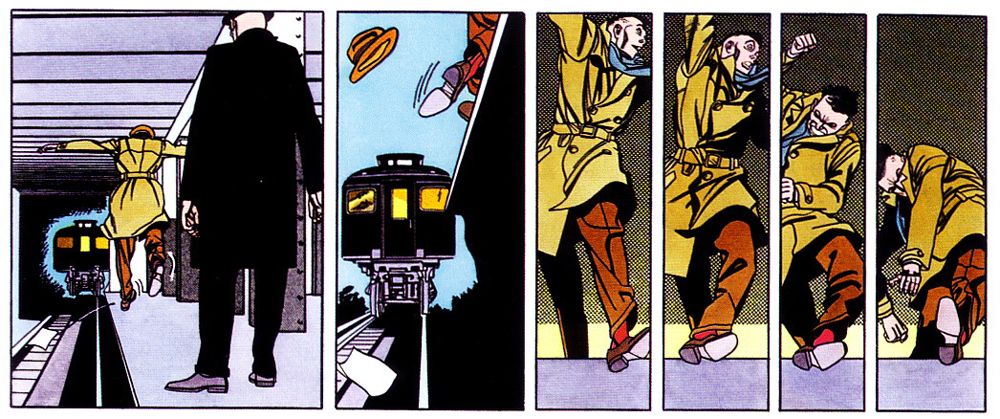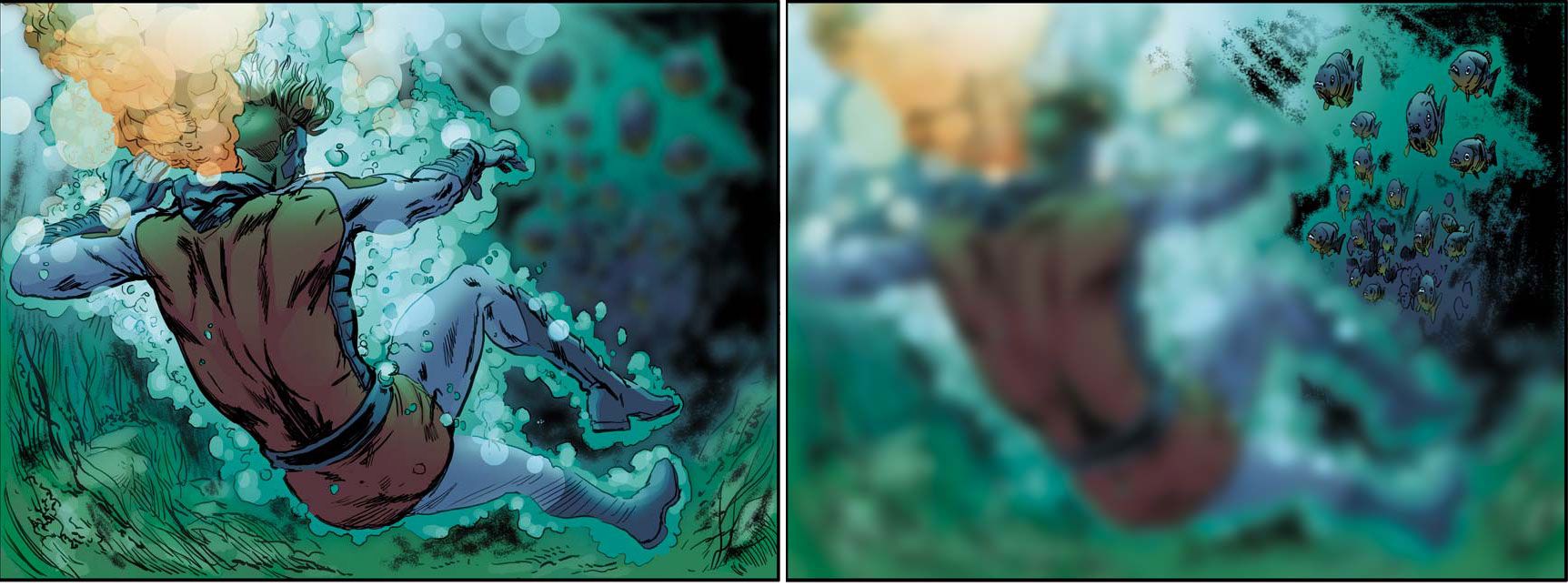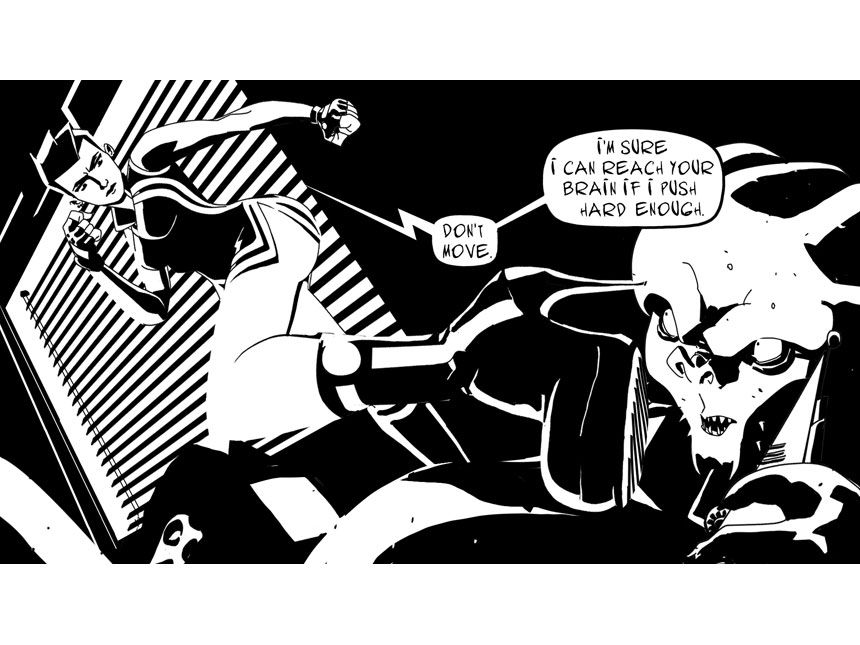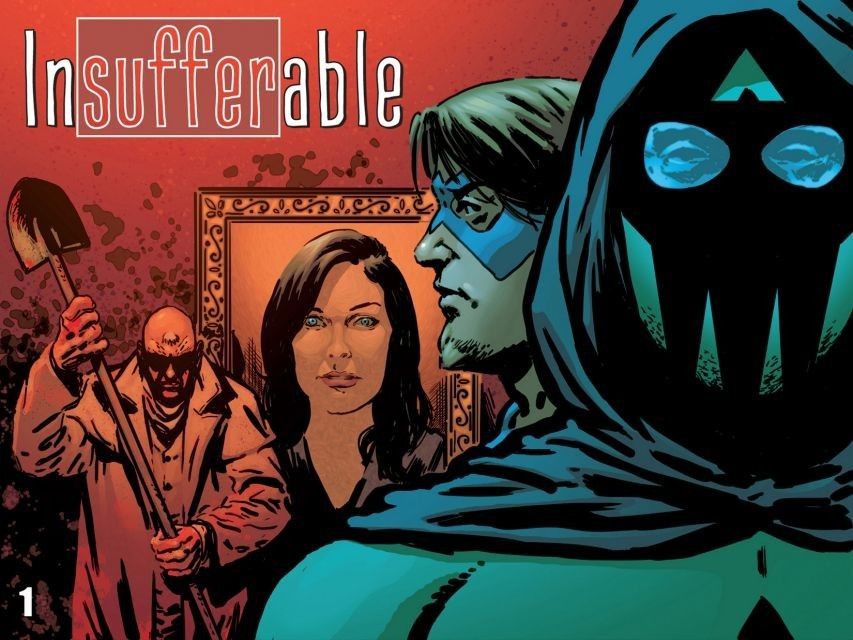Almost eight months ago, at Chicago Comic & Entertainment Expo, Mark Waid unveiled his grand experiment in digital comics, Thrillbent.
A veteran writer for DC Comic and Marvel, Waid is the creator of the alt-superhero series Incorruptible and Irredeemable, former editor-in-chief and chief creative officer of BOOM! Studios, and the winner of three Eisner Awards this year for his work on Daredevil. In other words, he knows his comics. But with Thrillbent, Waid struck out into the unknown, creating a digital-comics site and using it to host his newest comic Insufferable.
The end of the year seemed like a good time to touch base and see what Waid has learned so far and what he plans to do next with Thrillbent.
Robot 6: What has been the hardest part of all this so far?
Mark Waid: Besides working for free on my own end of it, the hardest part by far has been making the jump from print to digital in terms of story construction. When I started out with this idea over a year ago, I still had in the back of my head that we would be doing print comics out of digital comics fairly easily. I wanted to do comics in a 4/3 ratio so we could stack one on another and make a comics page. Trying not to do in digital what I can't do in print was such a bad mistake. If you're going to do it, do it right, go all in, is what I learned. That was a hard leap to make, but once I made it, it was very liberating. It made me a lot less cautious, and it narrowed my focus so I no longer had to feel that I was serving both masters, print and digital. Then being able to use different techniques like rack focus, repeating panels, pop-up dialogue, that you can't do in print becomes a reality, and it made us all the more adventuresome—I don't mean just me, I mean my collaborators. I made the mandate fairly early on: Don't worry about print; we'll figure it out later.
What storytelling techniques are you finding work well in digital?
The ones that work extremely well are the ways you can play with timing, the way you can play with the pace of storytelling. I continue to maintain that our bellwether philosophy is the reader must stay in control of the pace at which he "turns the pages," because that's what makes comics. Otherwise, it's just a passive viewing experience and cheap animation. That said, you can still play with the pacing of comics.
The most influential print comic to me when it comes to digital, and one that I send out to all the people who want to do something with Thrillbent, is a 1952 EC comic, Bernie Krigstein's "Master Race," from Impact Comics #1. Bernie Krigstein would have been a brilliant digital comic artist if he was alive today. In that story Krigstein does interesting things with panel repetition or thinly slicing certain panels so you get a strobe effect as a subway car races by, or he slows down a moment of action, of someone falling on the subway tracks, by carving it into six or seven tiny vertical panels, and that's as much an inspiration for what we are doing as anything. I still think that's comics, yet within the confines of comics he is still using panel sizes and shapes and that dictates the speed at which the story passes before my eyes. With digital we can do that every time.
In one of the recent Insufferable installments, I wanted a beat between a character's lines. I wanted him to say something and then us as a reader to hold our breath and pause to see what he says next. So what we did was take the same panel and repeat it four times across the page. The first time you swipe the page you get the one panel, silent. On second swipe you get same panel duplicated, then on the third time, if I'm doing my job right, you are holding your breath, and on the fourth swipe he actually says something.
The rack focus, the idea that you are focused on one element in the foreground and on the swipe the focus changes to the background, or vice versa, that is something that Stuart Immonen pioneered with that Avengers/X-Men comic. He's the one that came up with that idea and it opened up new vistas for us.
I think what we get out of digital is, in some ways, a closer cousin to manga than traditional American comics because with a lot of manga they are not afraid to take the elbow room you need to tell these kinds of stories. With digital, even I was surprised to see that with that first installment of Insufferable, it feels to me like about eight pages, but it ends up being 20 or 30 swipes across the page. Since you are not paying for paper or additional art, you are using digital to help expand your canvas, it doesn't cost any more to do more screens, expand the art, give the artist a little more breathing room, so why not?
I'll be honest: When I am reading manga in print — this is the American in me — a lot of times, I'll be thinking "Oh, my God, get on with it already." When I read it in print, it feels from my strict Western storytelling point of view that you are just burning daylight, but when I do it in digital, it doesn't feel that way, probably because it doesn't matter how long the sequence is going to be, it's not going to cost the reader any more. Even when we go to comiXology or start downloads to an iPad format, it's still not going to dictate how long the story is going to be.
How do you plan to bring in new readers?
The two tools that are most readily available are recruiting creators who have their own fanbases that are not necessarily your standard comics store audience — talking to writers who are not necessarily comics writers, talking to people from other media, and hoping their audience can add to our audience—and then using social media. This has been why we have been so transparent, because I want that sense of collegiality, that sense of fellowship between us and our fanbase where we make it clear to them we need your help to spread the word, and we need your help to retweet, post on Facebook, to share this material, and in return we will tell you everything we can tell you about the process of how it's going, so it becomes not "Watch us build a barn" but "Help us build a barn," and it becomes a community effort. Those are the tools that seem available to us readily. The bigger tools, paid marketing, advertising, these are frankly beyond us, not just because I only have so many hours in a day but also because we are at this point not revenue positive.
Are you making any attempts to bring in revenue right now?
Going in we knew that we weren't going to make a lot of money, if any, in the first six months to a year. That's OK. I'm paying the Insufferable guys, but Pax Arena was material that had already been done by two French creators, and they asked if we would be interested in hosting it over here. It's not costing anything, it is giving them a certain amount of exposure, so it's a fair trade.
We are doing the Top Cow Pilot Season material. They have this Pilot Season where they put out No. 1 issues of different series, and depending on a combination of reader votes and sales they decide which will go out to series. The problem is, it becomes a real diminishing revenue over the years, as the circulation of comics singles dwindles and print costs continue to rise. It didn't make any sense to do it as they normally did, but they pitched the idea of doing it through Thrillbent, so we will give Top Cow a section of Thrillbent that is their own, and they will run four or five digital comics with a reader voting component to see in American Idol-style which will come back next week. That doesn't bring in revenue, but it drives traffic to the site, and it draws attention to what we have been doing.
What I like about having so many different properties on Thrillbent in the months to come is that we get to play around with a bunch of different revenue streams. I don't see a point at which there is one revenue stream for Thrillbent. If John Rogers wants to do his series as a PDF download for a certain amount of money, or Gail Simone wants to do something where every month it's free, but for a $1.99 subscription you can get the next month in advance — there are different models to play with, and what excites me is the more material you have up there, the greater variety of choices we can experiment with. For me it's not about making money, it's about seeing what works.
Do you have ads on the site?
We decided to forgo ads. We weren't sure what the revenue would be, and on an aesthetic level, it's not worth a dollar a day to redesign the interface to take account of ads. We'll get there down the road, but right now it's not worth our time.
A little late in the game we talked about putting in a tip jar. The number of tweets, e-mails, Facebook posts, convention fans who come up and say "We realize this is free and we want to support you, how do we do it?" — hese are people who want to donate just to be part of the cause. We haven’t done that. If we put it up at the beginning of the site, I would feel better, but once it was up and running I was afraid people would feel we were hurting, and that's not true.
Why did you decide to put Insufferable on comiXology?
I know those guys, I like them. They finally cornered me at New York Comic Con and we talked about what the expected circulation would be from them, and they made it clear it didn't have to be an exclusive deal. ComiXology said, "Consider us another distribution channel," and in that case, not doing it through comiXology would be leaving money on the table. ComiXology has market penetration that we don't; it's the No. 3 paid app [in the iTunes store] in 2012. We are going to be flooded by people who are downloading Insufferable who have never heard of Thrillbent, but this will send them back our way.
How's it going so far?
We have only been up a week or two. I don't know what the numbers are, but in Russia we are the eighth, ninth and 10th bestselling comics of last week, so take that, Spider-Man!
What we talked about was, if you guys can help me break even on a monetary basis, that would be awesome. That would be what we want to do. Based on the numbers they get on Incorruptible and Irredeemable, they were very confident that they could at the very least help me break even.
You have spoken about the costs of print comics, but what costs are you finding associated with digital media? Any surprises there?
I have yet to find a dollars-and-cents cost, but the cost in human hours — I was really not taking into consideration the fact that those are billable hours. In the grand scheme of things, that is money, in the sense that I could be writing another issue of Daredevil instead of doing that. I was taken aback at the amount of time just the production end of it took, looking at it and getting it up on the site and debugging it and making sure the flow is right. That's an afternoon every week just assembling the damn thing, and that's just one strip. That was the part I was blissfully unaware of going in.
And the social media aspect of it, going on Twitter and other sites, setting up a Tumblr account, which we will do next week — that takes time, but it's something we have to do.
You often talk in terms of publishing a comic digitally first, paying off the production costs that way, and then going to print. But have you considered going the other way, making your older creator-owned comics available digitally, to continue making money from comics that have already paid off their expenses?
I have, but I'm so deeply in love with that landscape format that I've looked at a lot of material that is creator owned that existed in print, my material and other people's material, and it's I loathe, loathe, loathe the idea of having to scroll down to see an entire page. I hate it with a white hot passion. I feel like it's antithetical to everything we are trying to do to teach people to read digital comics. I may break down on that still, I may just cave in and realize I'm fighting an unwinnable fight, and maybe there is room on Thrillbent for vertical comics and horizontal comics, but so far I have been very resistant. I have turned down some interesting creator owned material because while I love the material, it is built for the standard comics page. If I take those pages and try to adapt them to what we are doing, it feels like I am taking a wide screen movie and adapting to pan and scan. I feel so strongly the material has got to be created for the space it takes up, not adapted to some other format.
So you are thinking of reading digital comics on a computer, rather than a tablet, which has a default vertical format?
True. That's very much how I feel. The default format for the iPad is vertical, yes, but I find that there's no resistance from iPad users to going from vertical to horizontal, to going back and forth, depending on what they are looking at. Looking at the world around us, the majority of the screens in our life are landscape format screens, whether television, computer, laptop, or iPad half the time. It wasn't so much that I was looking for computers specifically as I was trying to go for what I saw around me in the greatest number, which are horizontal screens.
Are you thinking of offering several levels of storytelling, maybe simple PDFs and enhanced digital comics with other features?
In our dream world down the road, yes, but we are trying to master this one as best we can. While we are putting PDFs up, we are doing it with the knowledge that this is not the best format to read this comic. We know we are going to get pirated right off the bat, so if it's going to get pirated, let's give them the files to work with rather than just let them create them themselves, because that way we get to put in a credits page.
How is that working out?
Great. The traffic we get, it is hard to track exactly, but I do know that I consider it a victory that whenever those torrented files are put up every week they still have that last page of material that says hey, come back for more Thrillbent stuff. It's easy to take out, but people don't. They want to help spread the word, which is great.
Do you think it makes a difference that people feel they know you — you're not some invisible corporation, you're out there in person on your site and social media, talking about what you do?
I think that is a genuine feeling. If you can build a relationship with your fans, they are less likely to think they are sticking it to the man than if it's me and I'm making it clear that the I'm doing my best. There will always be people who take material for free. You can't worry about that. You can't stop it. What you can do is maximize the people who want to help.
There was this card game, Cards Against Humanity, it's like the adult version of Apples to Apples. They put out a holiday pack and said "Pay what you think it's worth," and holy crap! They suggested people pay $3, most people paid about $5, so the total profit was $70,000. I think that's just phenomenal. If you hit it right, if you make a personal connection, there are always people who will support you, and I think that's great.
That is the economy of the 21st century. It is going to be peer to peer. We are cutting out distribution costs, we are cutting out the big media conglomerate distributors, we are going straight to the audience, and they get to help determine what the material is worth. Some will make a lot this way and some will make less. That's the new economy, and I am ready for it.
Have you considered Kickstarter?
We talked about it. In retrospect I have no idea why I was resistant to it. It may be something we play around with in the near future if we can find an attack mode for it. I like the basic model, I just don't know what to do with it yet. Honestly, that's how we will probably go to print; we will probably do it through IndieGoGo because it has more international penetration. I like the grass roots aspect of it. The only downside with Kickstarter is that so much of that machine is already built, and I like reinventing the wheel. I'm a guy who in a perfect world if I had nothing but time on my hands would scratch-build my car just to see how it all works, and I apply that same thing to Thrillbent. Going through IndieGoGo or Kickstarter is interesting to me, but I would prefer to do it through our own site because that way I find out what works and what doesn't.
What are your plans for Thrillbent for 2013?
I keep my sights realistically low. My immediate goal is to get new material up every weekday. We may not get there immediately. From there, we have had talks with some studios, we have had talks with networks, we have had talks with businesses who say "We see you are doing new media, we want to be involved, where do we buy in?" My answer is "I don't want to sell, there's nothing to buy, but how can we work together so we can use your customer base and your tools?" It's a hard question to answer because there's so much to figure out. So for instance, let's say Movie Studio X comes to us and says we "Want to partner up"—and that's happened—what does that mean? If this was the print medium, or we were a digital video series, there are models for that. But there is no model for this. When you sit down at the table with Movie Studio X, what does that mean? Does that mean you are paying for production costs in return for a first look deal? Do you get partial ownership on some of the series? We have so many creators aboard that we have to go to each of them and say "Do you want to be part of this?" We are trying to hack this giant piece of granite into a statue you can recognize. We have had many, many phone calls and many, many meetings with outside interests who have come to the table with checkbooks wanting to know how they can play with us. I think that's awesome, I am pursuing that with all the verve I possibly can, but I love sitting down with these guys and I say "What does this mean?" and they say " I don't know" and we are figuring that out. This is a good problem to have, by the way.
I don't want to say it's not about the money, because part of the goal is prove to younger creators that this is a viable business model: You may not get rich, but you will get paid, and you won't have to live on ramen noodles or the rest of your life. That's the number one goal. The first rule of new media is nobody gets rich but everybody gets paid. If we can get to that point, I'm happy with that.





